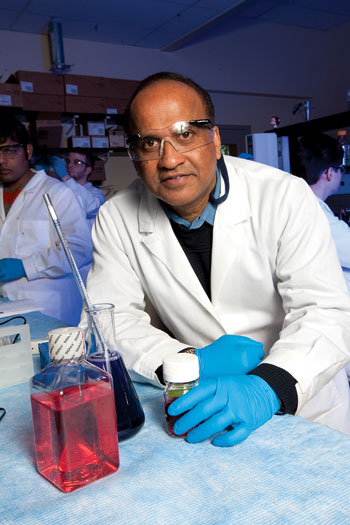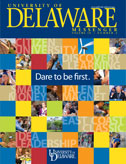Biologist takes his work to heart

RESEARCH | Ulhas Naik knows the dangers of heart disease, both scientifically and personally. The professor of biological sciences at UD and director of the new Delaware Cardiovascular Research Center has a family history of the disease.
Three of his brothers died instantly from heart attacks in his hometown in India, and his only living brother has had quadruple bypass surgery. Naik himself takes medication to lower his cholesterol and sees his doctor regularly for heart checkups.
Now, however, he may be hot on the trail of the world’s No. 1 killer.
A leading cardiovascular researcher recently named a fellow of the American Heart Association, Naik has targeted his research over the past two decades on blood clot formation, which is the direct cause of heart attacks and strokes.
Blood clotting is a complex process involving platelets—the smallest of the blood cells and shaped like a disk, which start clumping together when a blood vessel is wounded—and plasma, the sticky fluid rich in proteins and chemicals that makes up more than 50 percent of our blood.
About 15 years ago, Naik began working on Junction Adhesion Molecule A (JAM-A), a protein present in platelets and the endothelial cells that line the blood vessels. He became the first person to biochemically characterize the protein and clone its gene. He also discovered that, in the absence of JAM-A, platelets clump together more readily. Thus, he believes the JAM-A protein may play a key role in preventing blood clots from forming, and National Institutes of Health (NIH) studies focusing on the protein are ongoing in Naik’s laboratory.
Currently, in a pilot project funded by the Delaware Health Sciences Alliance, Naik is examining defects in the JAM-A protein as a potential risk factor for congestive heart failure, also known as dilated cardiomyopathy.
His collaborators on the study include Dr. Takeshi Tsuda, pediatric cardiologist at Nemours/Alfred I. duPont Hospital for Children; Dr. Walter Koch, W. W. Smith Professor of Medicine and director of the Center for Translational Medicine, and Dr. Erhe Gao, research associate professor, both from Thomas Jefferson University; and Dr. William Weintraub, director of the Center for Cardiovascular Outcomes Research at Christiana Care Health System.
According to the American Heart Association, about 5.7 million Americans are living with congestive heart failure, and that number is expected to increase as the baby boomers age.
“As we grow older, the heart often becomes larger because it has to work harder to pump efficiently,” Naik says.
The research team, which also includes UD graduate student Chris Schmoyer, is conducting laboratory studies with mice. A portion of the project also will focus on screening human patients to see if a correlation can be made between mutations in the JAM-A gene and the risk of developing dilated cardiomyopathy or of having poor survival after a heart attack.
“For patients with coronary artery blockage, some recover from a heart attack and some don’t, and physicians don’t know why,” Naik says. “Is the JAM-A protein defective or missing in these people? If so, it could be an early indicator of high risk, or it could open the door to gene therapy potentially farther down the road. I think we have a ray of light that’s important to pursue.”





